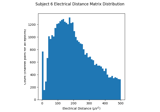mne.preprocessing.compute_bridged_electrodes#
- mne.preprocessing.compute_bridged_electrodes(inst, lm_cutoff=16, epoch_threshold=0.5, l_freq=0.5, h_freq=30, epoch_duration=2, bw_method=None, verbose=None)[source]#
Compute bridged EEG electrodes using the intrinsic Hjorth algorithm.
First an electrical distance matrix is computed by taking the pairwise variance. Then, a local maximum near 0 \({\mu}V^2\) and a a local minimum below 5 \({\mu}V^2\) are found, the presence of which is indicative of bridging. Finally, electrode distances below the local minimum are marked as bridged as long as they happen on more than the
epoch_thresholdproportion of epochs.Based on [1][2][3] and the EEGLAB implementation.
- Parameters:
- instinstance of
Raw,EpochsorEvoked The data to compute electrode bridging on.
- lm_cutoff
float The distance in \({\mu}V^2\) cutoff below which to search for a local minimum (lm) indicative of bridging. Defaults to 16 \({\mu}V^2\) to be conservative based on the distributions in [2].
- epoch_threshold
float The proportion of epochs with electrical distance less than
ed_thresholdin order to consider the channel bridged. The default is 0.5.- l_freq
float The low cutoff frequency to use. Default is 0.5 Hz.
- h_freq
float The high cutoff frequency to use. Default is 30 Hz.
- epoch_duration
float The time in seconds to divide the raw into fixed-length epochs to check for consistent bridging. Only used if
instismne.io.BaseRaw. The default is 2 seconds.- bw_method
None bw_methodto pass toscipy.stats.gaussian_kde.- verbosebool |
str|int|None Control verbosity of the logging output. If
None, use the default verbosity level. See the logging documentation andmne.verbose()for details. Should only be passed as a keyword argument.
- instinstance of
- Returns:
Notes
New in version 1.1.
References
